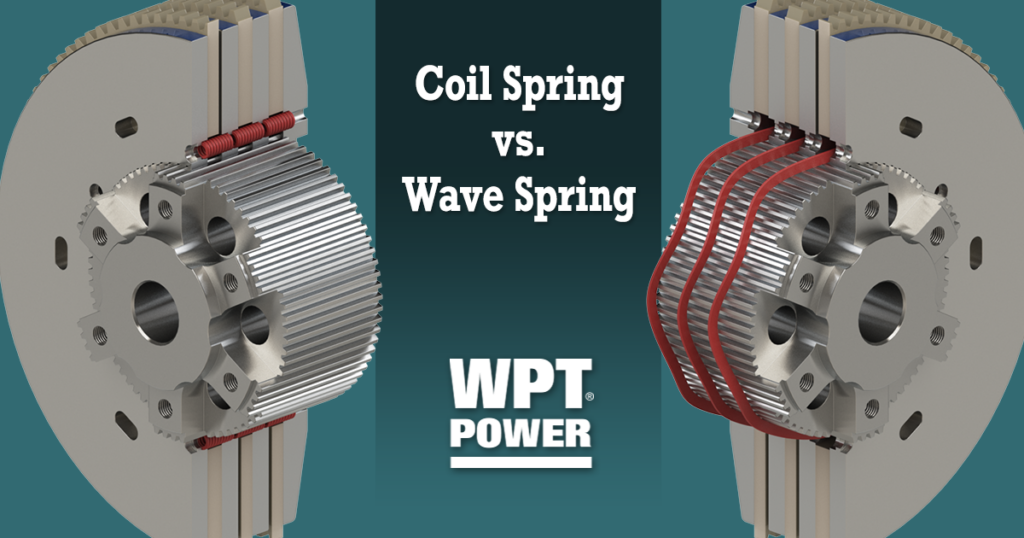
If you find yourself in the world of the WPT Power Grip clutches, you will eventually come across release springs. This also means you will be presented with a choice, coil, or wave. In this article, we will discuss release springs and help determine which spring is right for your Power Grip clutch.
What is a Release Spring?
Release springs are located between the center plates and their primary purpose is to help separate the plates during disengagement. When air or hydraulic pressure is released from the clutch, the release springs help push the plates apart. This reduces the time it takes for the clutch to release and reduces slip time. It also helps to keep the plates from touching while not engaged.
Where are They Used?
The release spring is used in many kinds of clutches and brakes throughout the WPT lineup. However, the focus of this article is on the Power Grip clutch. Because with Power Grip clutches, there are two types of springs used, coil and wave.
What is a Coil Spring?
A coil spring is a very common type of spring. It is typically made from metal wire that is wrapped in a coil around itself. There are many types of coil springs, depending on the application. However, most of the coil release springs used in WPT clutches are heavy-duty die springs.
What is a Wave Spring?
A wave spring may not be something you have seen before. In the WPT lineup, it is only used in Power Grip clutches. The wave spring is made from hardened flat steel wire. Like the coil spring, a wave spring is wrapped around itself. However, waves are added to spring that provide the spring force.
What are the Pros and Cons?
From a performance perspective, both springs will function very similarly. They will both provide fast, reliable release of the clutch. The main difference between the two types of springs used at WPT is due to the speed. The wave spring cannot be rotated beyond a specific rated speed. Otherwise, it can come unwound. The coil spring does not have this issue. Another benefit of the coil spring is it is available in different materials and coatings for use in marine environments.
| Clutch Size | Maximum Speed [r/min] |
|---|---|
| 14 / 14H | 1140 |
| 16 | 1040 |
| 18 / 18H | 940 |
| 21 | 890 |
| 24 /24H / 24SHD | 750 |
| 27 | 720 |
| 30 / 30H | 690 |
| 36 | 480 |
A huge benefit of the wave spring is the ease of installation. Unlike the coil springs, the wave spring rests on the hub during rebuilding. This is particularly useful if your clutch is mounted on a machine with a horizontal shaft. Also, with fewer springs to install, spring installation is much quicker. In a 3-plate unit, there are only three springs. Compare this to the 18 coil springs and you can see how the time savings add up.
| PROS | CONS | |
|---|---|---|
| COIL SPRING | Suitable for high-speed applications | Difficult to install |
| Available in different materials and coatings | Easy to drop | |
| WAVE SPRING | Easy installation | Limited by speed |
| Can be retrofit into existing clutches | No marine options available | |
| Saves time |
How to Choose?
Choosing the right release spring for your WPT clutch is easy. Choose the wave spring. Unless you have a high-speed application, like a diesel-driven machine or high rpm electric motor, the wave spring is going to be the best option, every time.
One other point to consider when choosing is the operating environment. WPT coil springs are available with various metals and coatings that protect from harsh marine environments. The WPT wave spring does not have marine options, so it is not suitable for this type of application.
Wrapping it All Up
In summary, both types of springs will provide a smooth and quick release when your clutch is disengaged. For high-speed applications, you will want to stick with coil springs. For all other applications, you will want to use wave springs.
If you want more information or help selecting the right release springs, be sure to check out our website. You can also contact us at info@wptpower.com or 940-761-1971.
Written By: Jeremy D. Bodine, Senior Sales Engineer
